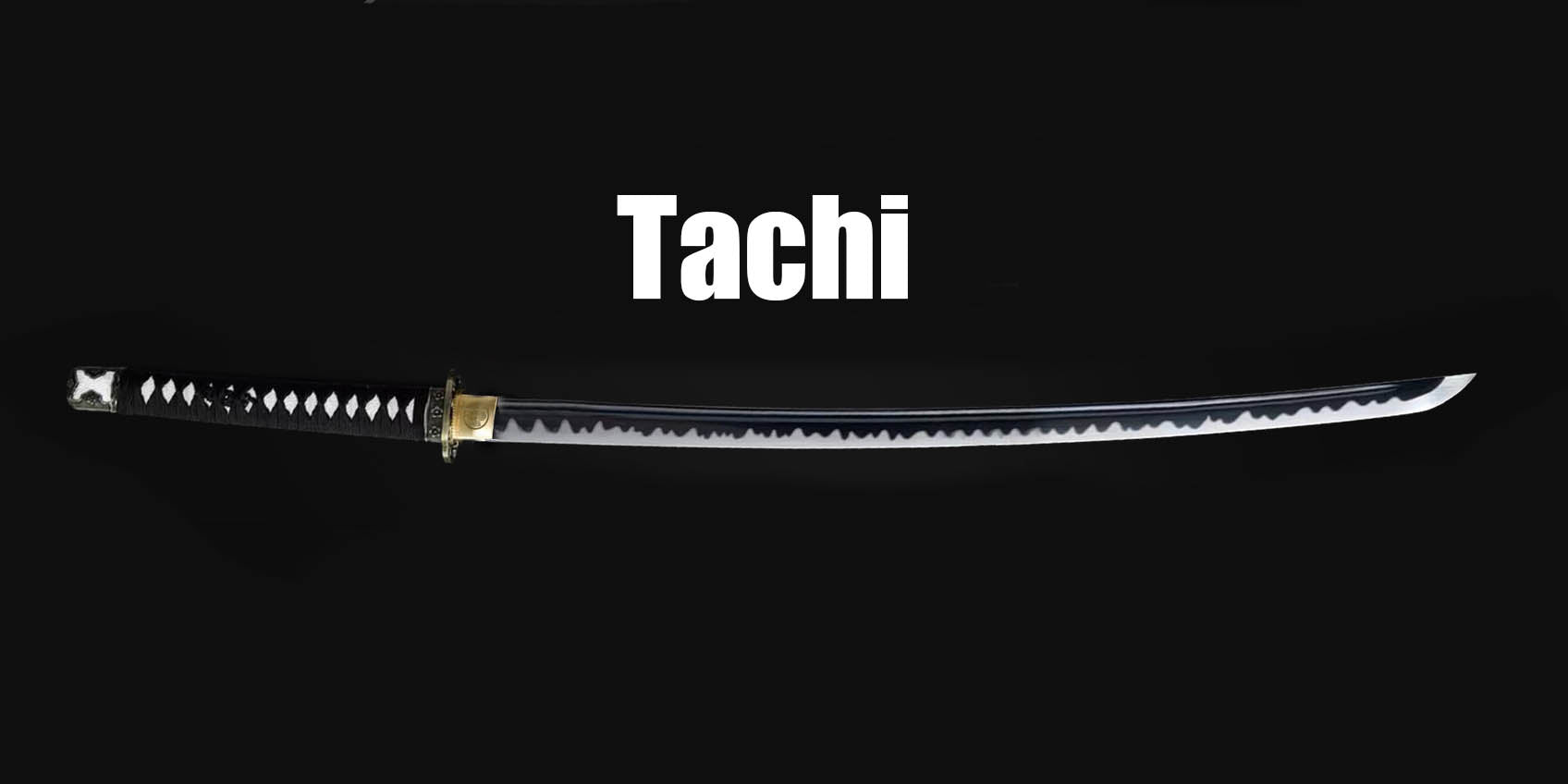How to Use a Katana Sword: Tachi vs Katana Techniques Explained

Among the many Japanese blade weapons, the Tachi undoubtedly stands as one of the oldest and most culturally significant samurai blades in history. If you're exploring different katana sword types, comparing types of samurai sword, or researching historical different katanas, then learning about the Tachi is an essential first step.
1. Difference Between Tachi and the Modern Katana — Tachi vs Katana
When discussing katana sword types, many people confuse Tachi and Katana. However, they differ significantly in historical evolution, design, usage, and cultural meaning.
1. Fundamental Difference in Carrying Style
-
The Tachi was worn suspended with the edge facing down, usually hung on armor’s exterior, allowing cavalry to draw and strike from height. This method was both practical and ceremonially refined, making it the official sword of noble warriors and generals.
-
The Katana is traditionally worn thrust through the belt (obi) with the edge up, facilitating a fast draw. It emphasizes 'draw-and-strike' techniques and became the standard infantry sword in later eras.
2. Blade Design and Curvature
-
Tachi blades are generally longer and more curved than katana, with pronounced curvature suited for heavy cavalry slashing—typical of the Heian and Kamakura periods in Japanese blade weapons.
-
Katana are more straight and suited for close-range draw attacks, particularly effective with martial arts like iaido.
3. Historical Context and Era
-
The Tachi originated in the late Nara period and flourished through Heian and Kamakura as the hallmark sword of noble cavalry. It was central to ancient samurai society.
-
The Katana rose in prominence during the Sengoku period, becoming widely used in the Edo period to suit infantry warfare, urban conflicts, and bodyguard duties, overtaking the Tachi as the mainstream samurai blade.
4. Decoration and Naming Tradition
The Tachi is not just a weapon—it’s a status symbol and art piece. Its scabbard and guard are often adorned with lacquer, gold, and carvings, and the blade is inscribed with clan crests or samurai sword names and katana nicknames such as:
-
'Onimaru Kunitsuna' – a legendary sword said to ward off demons.
-
'Kiku-ichimonji' – named after the chrysanthemum crest of the imperial family, symbolizing nobility.
-
'Ookanehira', 'Dōji-giri Yasutsuna' – among Japan’s legendary 'Five Swords under Heaven.'
These names are not only identifiers but also legendary symbols of what swords did samurai use, highly valued by collectors and history enthusiasts.
5. Dual Value: Collectible & Functional
Modern collectors regard Tachi as a high-end category distinct from Katana, listed among the premier types of katanas. They are prized for historical essence, artistic craftsmanship, inscriptions, and traditional wearing styles:
-
Featured in Japanese sword museums.
-
Used in film, ceremonial martial arts, and cultural exhibitions.
-
Available as custom replicas with engraved names like 'Minamoto no Yoshiie' or 'Ashikaga Shogun.'
In sum, from combat techniques, wearing style, blade structure, historical symbolism, to cultural status, the Tachi is more than an early Katana—it’s an independent classic samurai sword. Its rarity and deep symbolism place it among the most coveted katana styles for collectors.
2. Tachi Blade Structure & Style — Katana Blade Types / Parts of a Katana
Each traditional Tachi embodies Japanese swordsmith mastery. Understanding its parts of a katana can help you appreciate both its functional prowess and aesthetic beauty:
-
Ha (edge/blade): Tachi typically have deep curves ideal for mounted slashing.
-
Tsuka (handle): Wrapped with ray skin and silk cord for long-duration grip.
-
Tsuba (guard): Rich in design, offering both protection and artistry.
-
Saya (scabbard): Often lacquered or gilded, engraved with family crests or the samurai sword name.
-
Hamon: The wave-like pattern developed via clay tempering, symbolizing blade quality.
A common transitional style is Hishizukuri Uchigatana, blending Tachi shape with Katana function—sometimes mistaken for a Katana but actually a critical step in the evolution of katana styles.
Handmade Japanese Tachi Katana, High Manganese Steel Full Tang with Grinding Hamon Black Saya
3. What Swords Did Samurai Use?
In the Sengoku and Edo periods, samurai often carried multiple blades, known as the Three Samurai Swords:
-
Tachi – used for battlefield slashing, especially on horseback.
-
Wakizashi – a short sword for indoor self-defense and seppuku rituals.
-
Tanto – a dagger-like weapon for quick strikes, ceremonies, or private defense.
Together, they formed a complete set of types of samurai sword and represent integral parts of samurai culture.
4. Comparing Tachi with Other Japanese Weapons — Tachi vs Naginata
While fierce, the Tachi was not the only battlefield weapon. Female samurai often favored the female naginata, a Japanese glaive. Comparing naginata vs other weapons:
-
Tachi emphasizes individual offense and fast draw.
-
Naginata excels in range combat and area control—ideal for women or shorter samurai.
-
Both are popular in martial arts and collectibles, with many wooden naginata for sale made for training.
This showcases how samurai chose weapons based on identity, gender, and tactical needs, enriching the diversity of different kinds of katanas and broader Japanese sword culture.
5. How Are Japanese Swords Forged? — How Are Katanas Made
Whether Tachi or Katana, their forging is complex:
-
Repeated folding – removes impurities, increases strength.
-
Clay tempering – achieves hard edge and flexible back.
-
Polishing – reveals sharpness and distinctive hamon.
-
Mounting fittings – handle wrapping, guard fitting, and inscription.
Each Tachi becomes a unique masterpiece—integrating craftsmanship, philosophy, and artistry beyond industrial weapons.
6. How Much Does a Katana Weigh?
-
Tachi are generally heavier, around 1.2–1.5 kg.
-
Modern Katana typically weigh 1.0–1.2 kg.
-
Wakizashi and Tanto are lighter for easy draw and carry.
This reflects their design priorities: Tachi for powerful slashes, Katana for swift strikes.
7. Modern Value and Collecting Significance of Tachi
With rising interest in Japanese culture, collectors, cosplayers, and martial artists are increasingly drawn to Tachi:
-
High-fidelity replica Tachi recreate classic designs for display or film.
-
Custom Tachi with engraved names or meaningful katana nicknames are popular commemorative pieces.
-
As an essential branch of types of katanas, Tachi collectibles are appreciating in value.
Conclusion: Tachi Is More Than a Weapon—it’s a Cultural Vessel
Whether you're a beginner in samurai culture or an experienced collector, the Tachi—an early katana style—is worth deeper exploration. It not only reflects the evolution of ancient warfare but also carries the philosophy, heritage, and artistry behind each samurai sword name. If you're seeking a blade with both combat capability and cultural depth, the Tachi is surely the most valuable and rewarding choice.









